A few months ago, I replaced my Core i9 MacBook Pro with a Raspberry Pi 4 model B with 8GB of RAM for a day, and I made a video and a blog post about the experience.
Obviously there's a vast difference between a new Core i9 laptop with 32 GB of RAM, a dedicated GPU, and a 2 terabytes of fast storage and a tiny Raspberry Pi running ARM. So it wasn't a fair fight, but I could do a lot of things well enough, and every generation of Pi has gotten better.
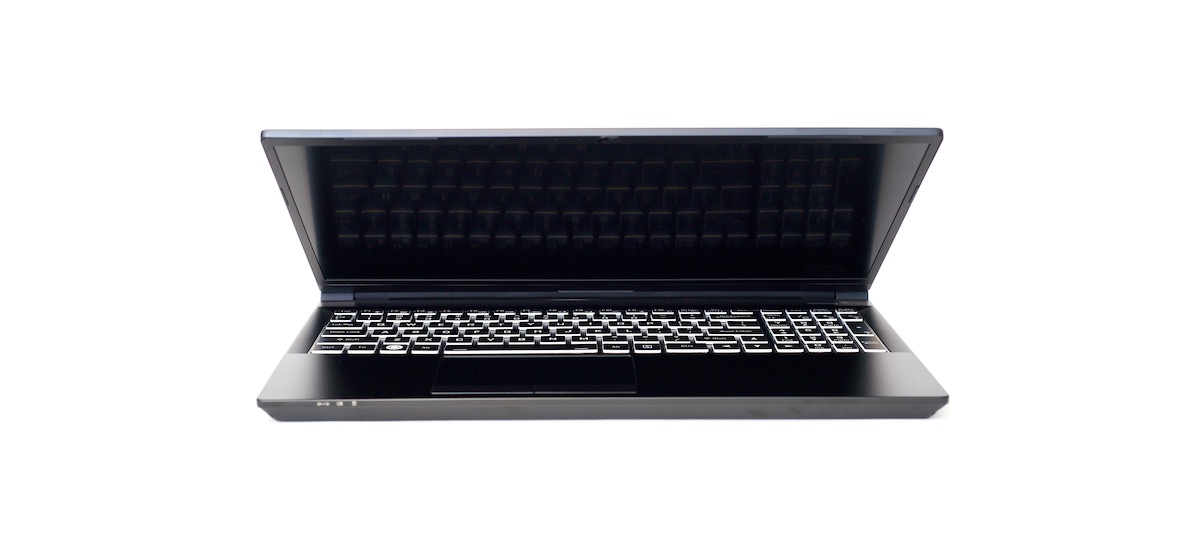
A few weeks ago, someone from Mindshare Management asked me if I'd like to do the same test, but this time with an almost one-for-one replacement laptop: the new Kubuntu Focus M2.
Review video: Check out the video that goes along with this review:
VIDEO: Can the Linux-powered Kubuntu Focus M2 replace my MacBook Pro?
I immediately responded, "Yes!"
I'm not keeping this laptop—it's a loaner. The folks at Mindshare Management / Kubuntu Focus have not paid me anything for this review, and I'm going to ship them back the laptop now.
I just wanted to see if a laptop that's built to be, and I quote, a 'PC Laptop to beat the MacBook Pro,' could really replace my Mac in my day-to-day workflow.
So does it?
Specs
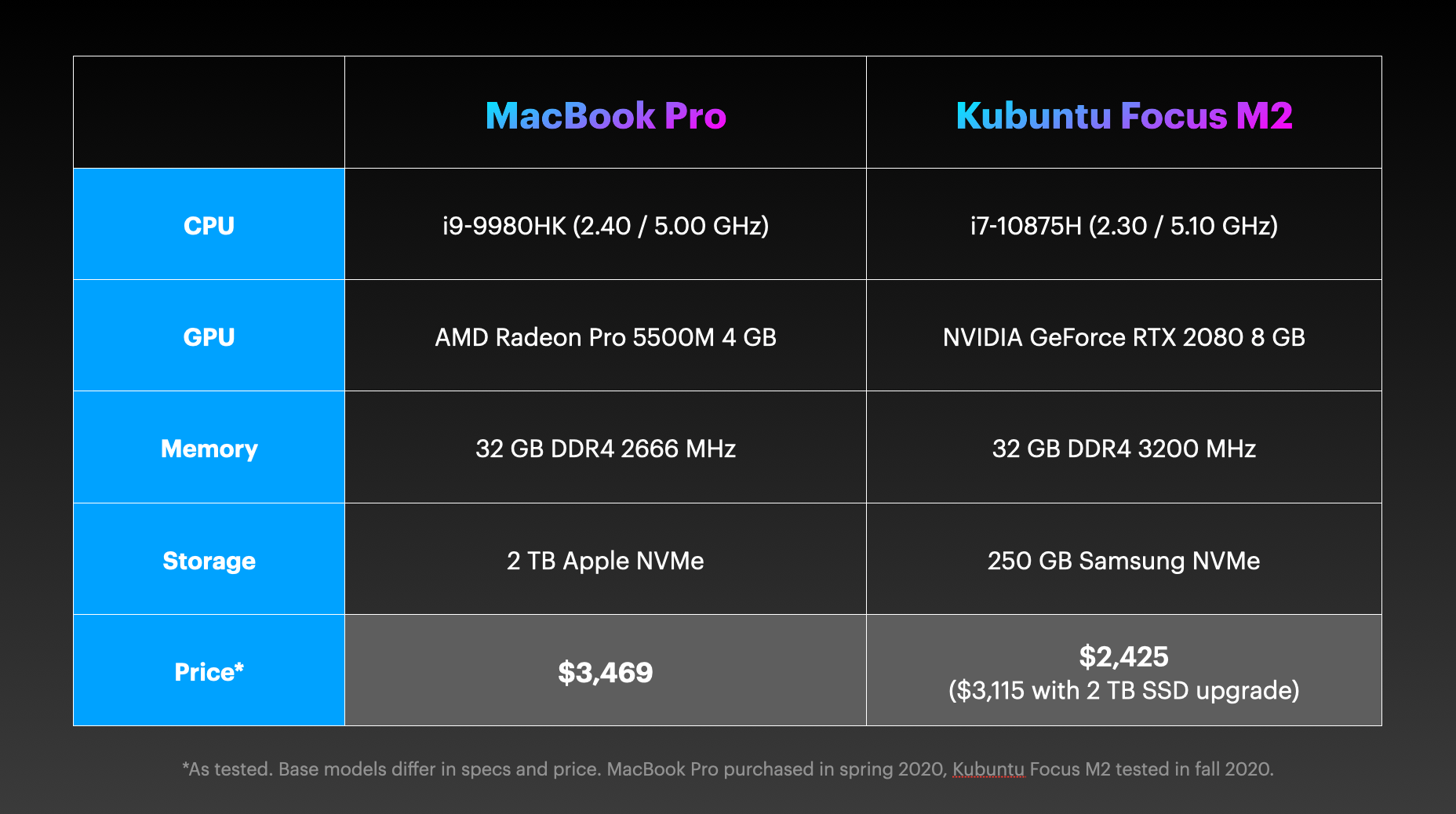
The processors are extremely similar, though the MacBook Pro has a 9th generation CPU versus the 10th generation CPU in the Focus. The GPUs are also similar in spec but the Focus I tested has a lot more VRAM. I don't game too much or use the GPU for AI or Machine Learning, but if you care about those things, having the CUDA cores in the Nvidia GPU and other Nvidia-specific features might be helpful.
The memory in the Focus is slightly faster, but it doesn't make a huge difference in most of my day-to-day work. The SSDs are comparable in performance, and you can configure up to 2 TB in the Focus. But if you're willing to pay Apple's steep price, you can expand the boot volume to 8 TB on the MacBook Pro (the Focus offers up to 4 TB combined storage with two 2 TB drives).
If you try match the two spec-for-spec, the Mac is still going to be around ten percent more expensive, but you have to consider the slightly better build quality, the higher quality screen, and other features the Mac provides.
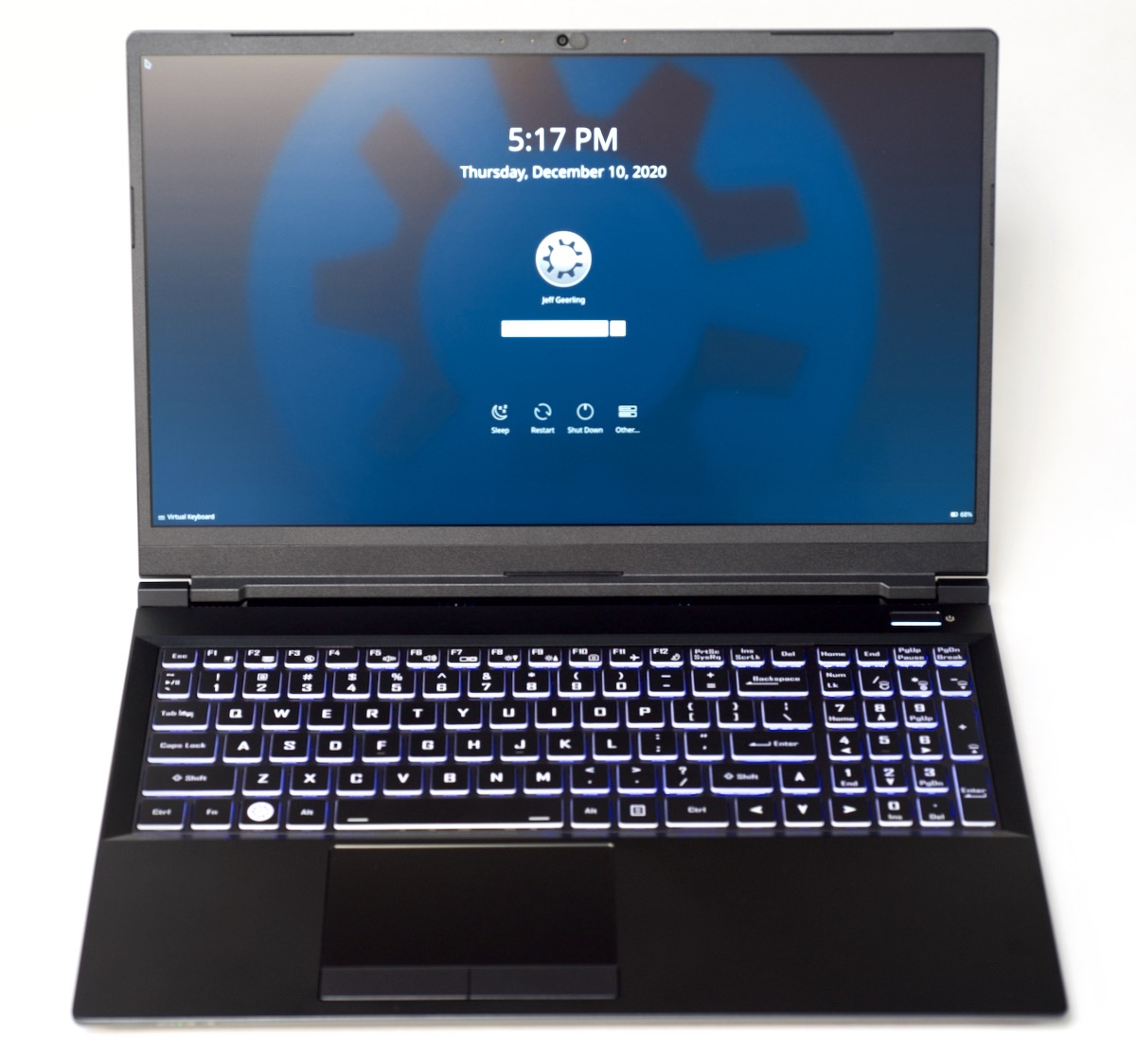
The hardware and design on the Focus is certainly good. It's a thin, light laptop with a typical chicklet keyboard, a glass trackpad, and an assortment of different ports and expansion slots. The laptop isn't quite as thin as the MacBook Pro, but the overall styling isn't garish, like the first version of the Focus was.
For an even deeper dive, this article on the Schenker Key 15 on Notebookcheck.net gets into the hardware and internals.
This laptop is not actually manufactured by Kubuntu or Mindshare Management. Instead, it's a Kubuntu-branded version of the Schenker Key 15.
Hardware overview
Since the Notebookcheck.net article contains a wealth of info on the internals, I'll just give a quick overview of the hardware itself:
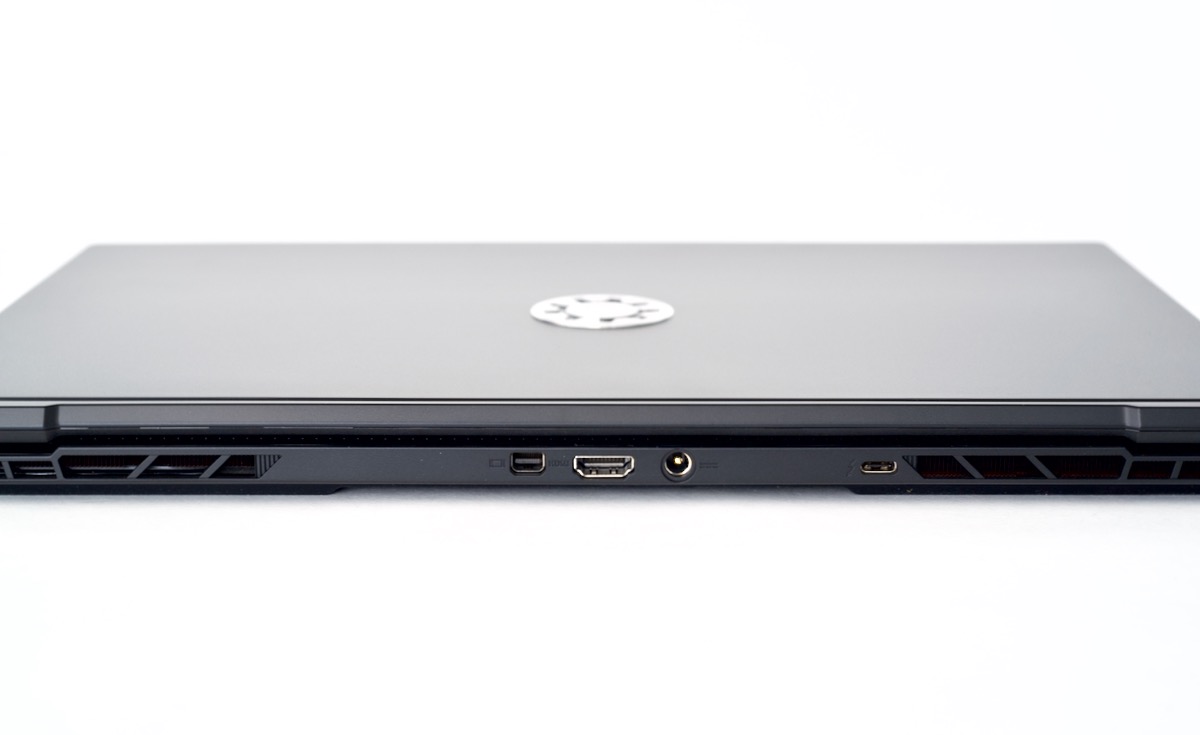
On the back, it has a ThunderBolt 3 port without power delivery, a power port, an HDMI port, and a mini DisplayPort.
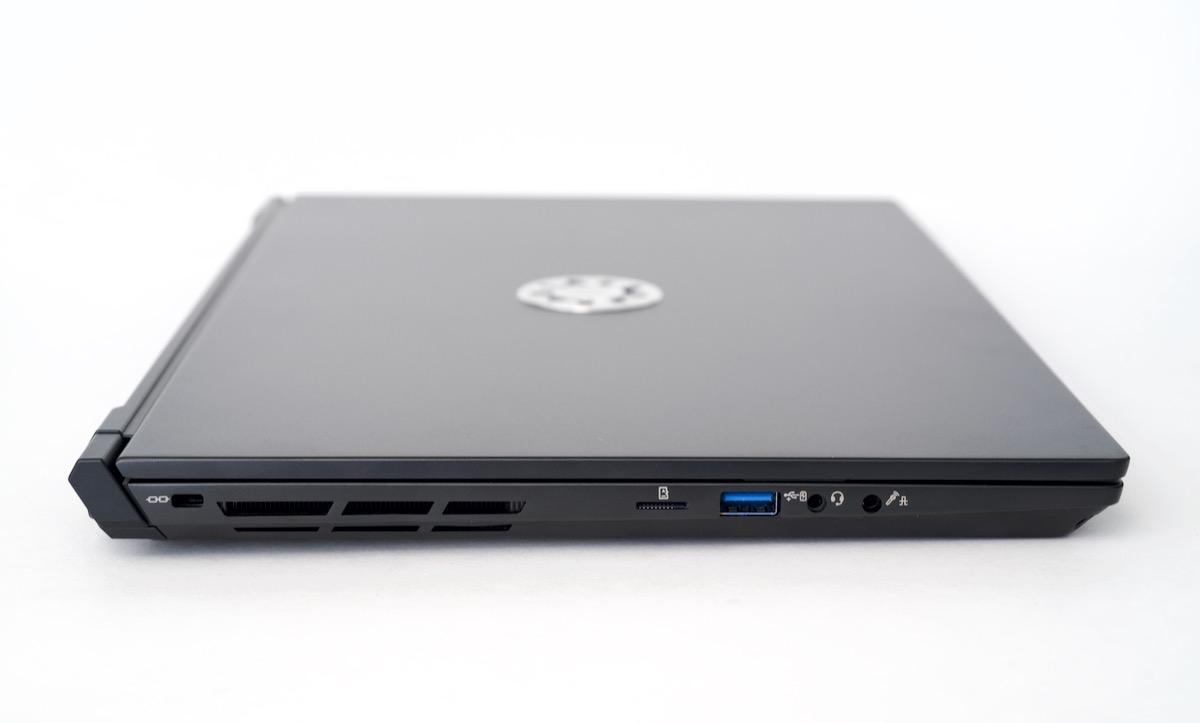
On the left side, it has a kennsington lock, microSD card slot, a type-A USB 3.0 port, a headphone jack with digital audio output, and a mic input jack.
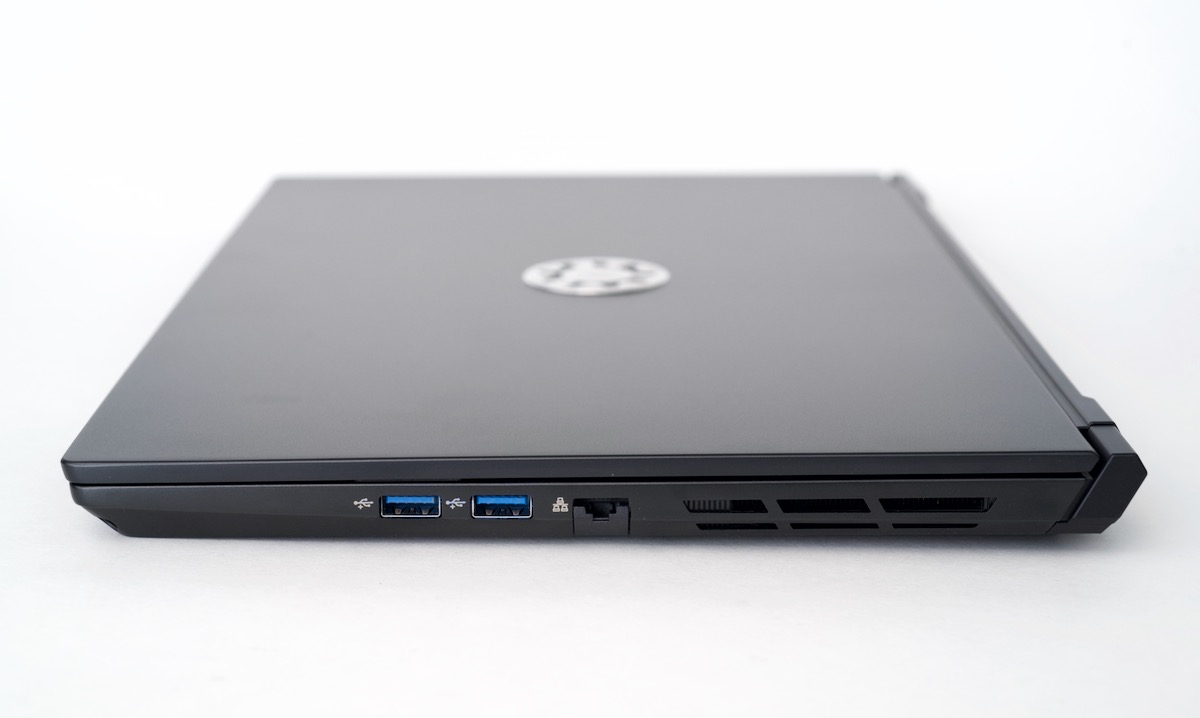
On the right side, it has two more type-A USB 3.0 ports and a gigabit network jack with a flip-down connector.
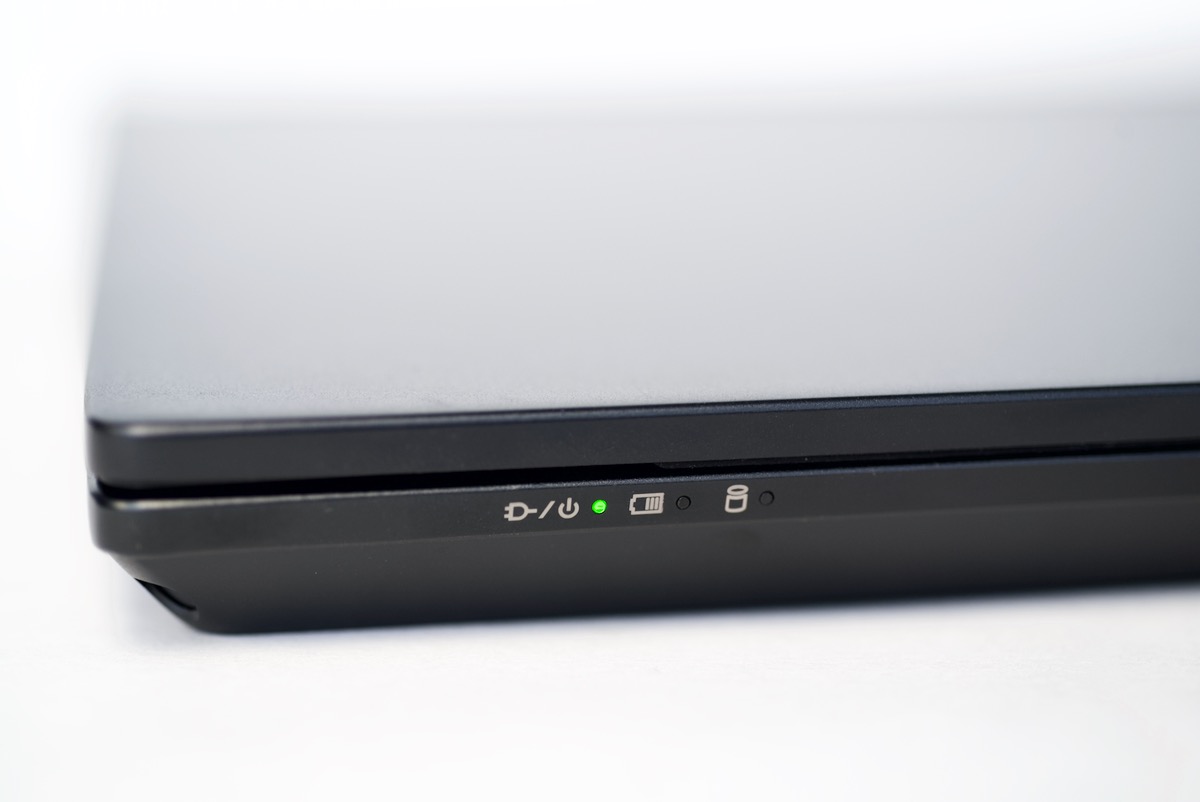
On the front, it has power, battery, and disk activity LEDs, which can be seen even with the lid closed.
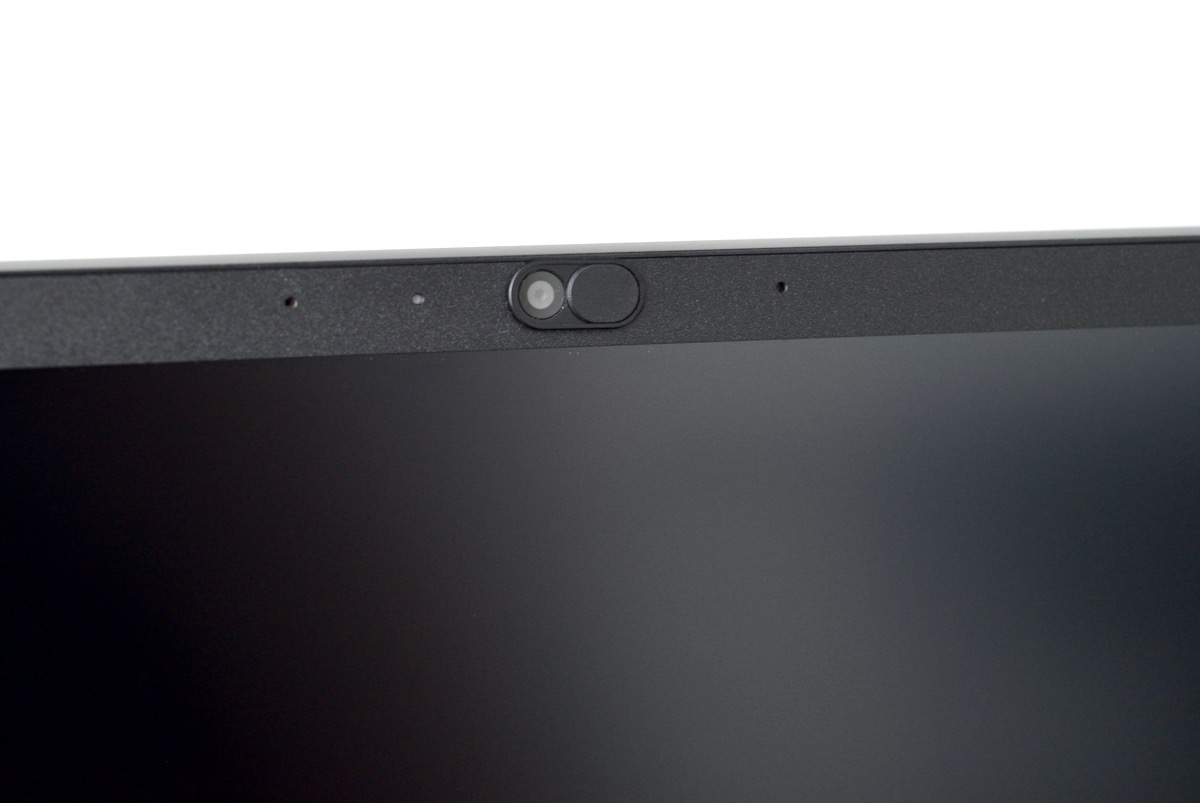
When you open it up, there's a mic and 720p webcam with a built-in privacy cover, a full-size keyboard with a slightly unique keyboard layout, and an offset trackpad with two physical buttons underneath.
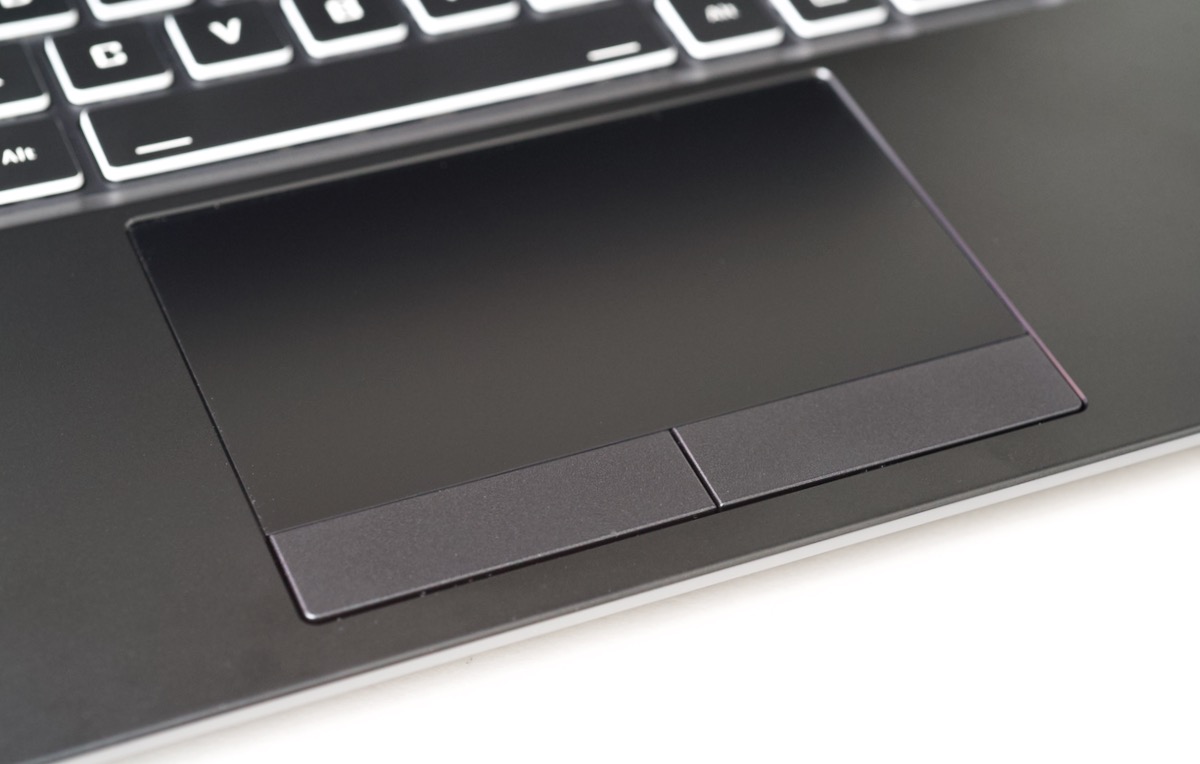
The fit and finish is very good, though it doesn't have the same solid feel as my MacBook Pro, especially the screen, which has a little bit of flex to it. The trackpad is generously-sized and feels great—but once you get used to Apple's massive glass trackpad, nothing really compares.
The keyboard has RGB LED lighting which can be configured via a hotkey, but I just set it to the whitish color setting (which is more of a light purplish-blue) when I needed the backlight (though I had to enable the backlight manually on battery power—unlike the MacBook Pro, the laptop doesn't seem to have an ambient light sensor that automatically enables/disables the keyboard backlight).
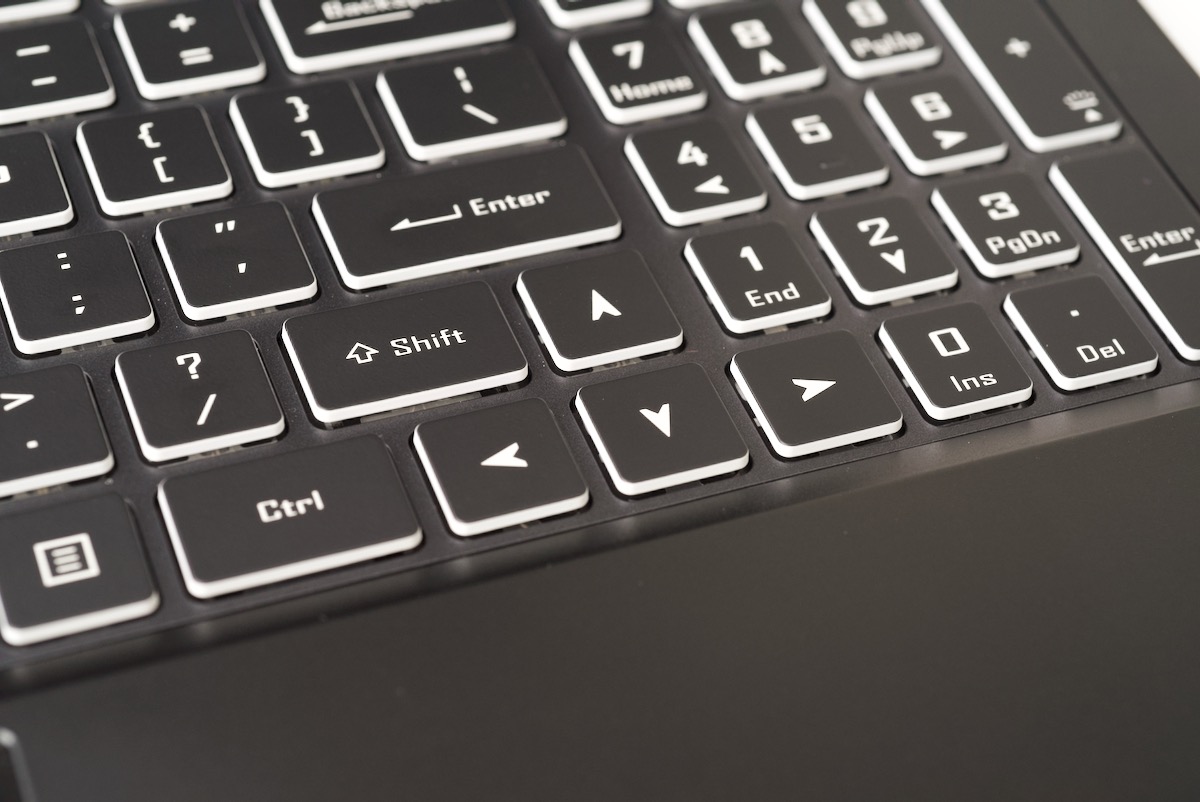
One thing I DON'T like about the keyboard is how the arrow keys kind of blend into the area around the shift key and number keys. It's really hard to get my hand on the arrow keys by feel.
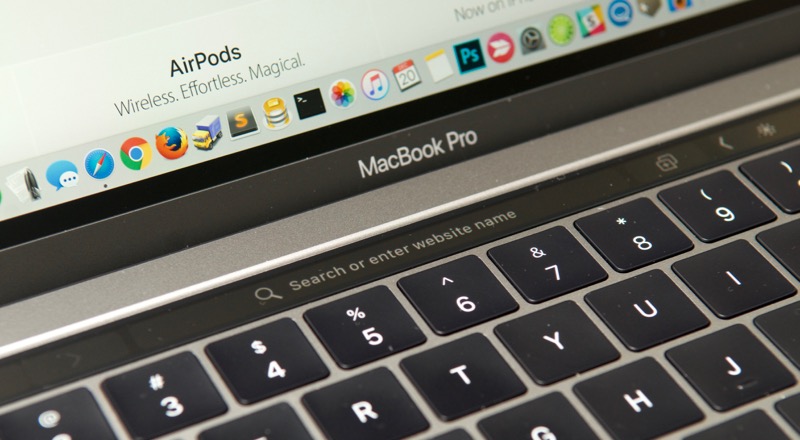
But one thing I DO like a lot is having REAL, tactile function keys. My MacBook Pro has this ridiculous Touch Bar that's no use to me, and is always hard to touch when I need to touch something on it, but easy to touch when I accidentally brush a finger against part of it.
Can you tell I hate the Touch Bar? I do.
Finally, one of Apple's distinguishing marks is their display quality, and this is one area where the Focus can't hold match up to the MacBook Pro. Not only is this only a full HD display instead of 'retina' or 4K resolution, it also doesn't have adaptive color or some of Apple's other OS-integrated features that make the screen that much more pleasant on my eyes.
But the display is certainly adequate, and I think is on par with what I'm used to on my 2017 Dell XPS laptop.
My Experience
The most important thing I can offer is my experience using the laptop, and what I liked and didn't like, both about the laptop itself, and how my different workflows translated from macOS to Kubuntu Linux.
The first thing I have to say is if you're considering switching from Mac or Windows to Linux, you should definitely treat yourself to a high-end laptop, ideally with great out-of-the-box software setup like the Kubuntu Focus provides.
That's the main reason I gave the Kubuntu Focus a second look—part of the big idea behind the Focus is having a turnkey Linux laptop that can be built to order and personally customized for a 'zero setup required' experience.
If you are like me, you don't want to spend 5 hours installing software and tweaking configurations, you just want to start doing work. And this laptop offers—in some ways—the best of both worlds.
Open Source Development
I'm an open source software developer, and almost all the software I work on runs natively on Linux—often in Docker containers.
On my Mac, one of the most frustrating parts of OSS dev work is having to run some things in Docker that require file sharing between my Mac's filesystem and containers. It's so slow, sometimes, that it's embarrassing.
There are ways to work around this issue, which I've used and even blogged about in the past, like setting up NFS for Docker containers, but like I said earlier, I want to do work on a computer, not sit around tweaking things.
And so the first test I did was setting up my own website (it's open source Drupal-based codebase is here) for development on both my Mac and the Kubuntu Focus.
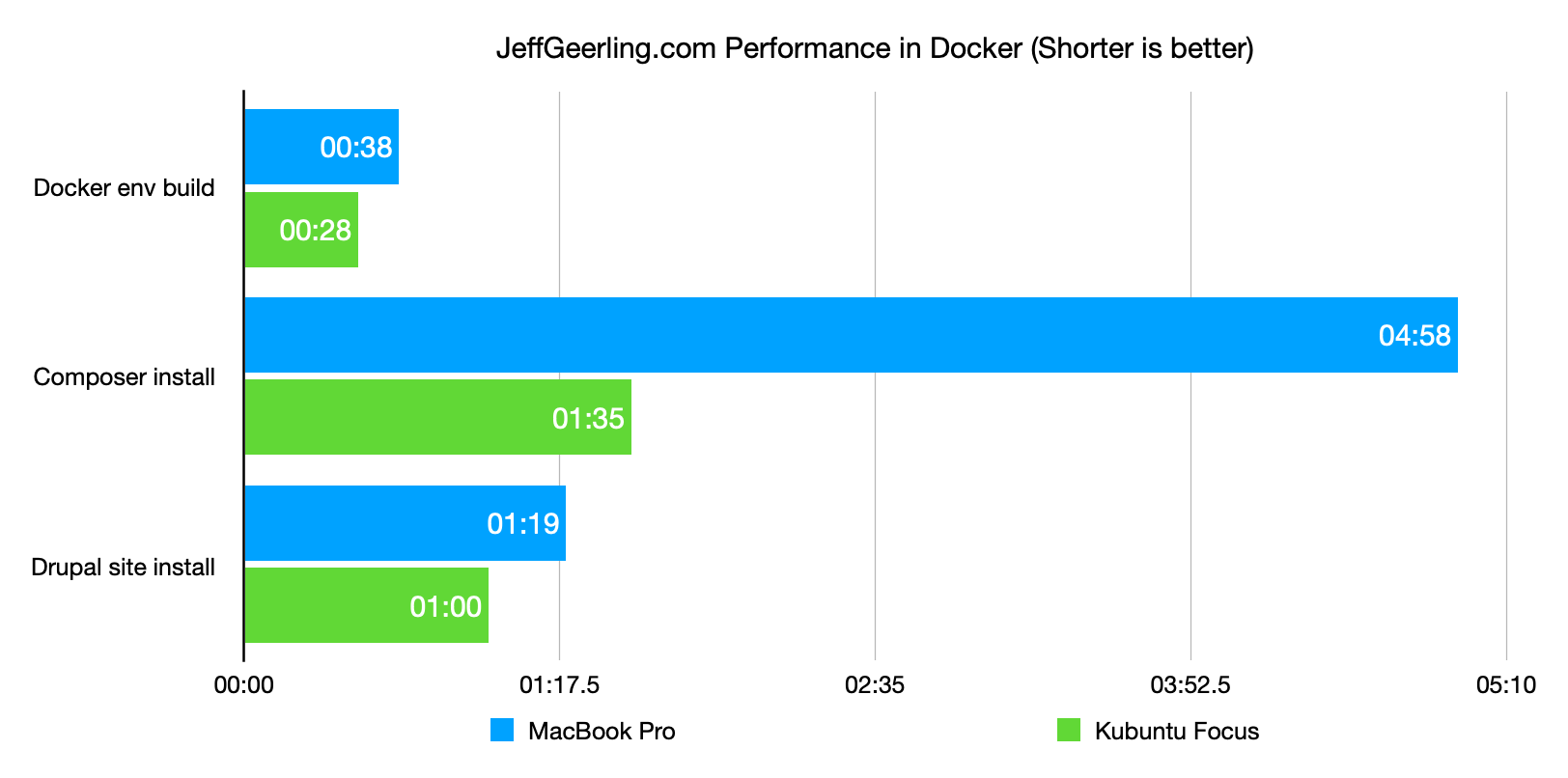
In general, even with Docker for Mac using an extra layer of filesystem emulation, things are 'fast enough', even though they're slower than running them on the Focus. But as you can see from the Composer install process—which copies thousands of small files to the filesystem—running native Linux allows the Focus to demolish the Mac in that benchmark.
Another thing that I often do is build or compile software, and lately, I've been having to recompile the Raspberry Pi Linux kernel over and over for PCI device testing on the Compute Module 4.
I set up a cross-compile environment on my Mac inside a Debian virtual machine, since that was the easiest way to get everything working. And I know some people will say I could tweak things or spend a few hours to get a native cross-compile setup working on macOS, and yes, that's true... but this was the easiest way to get everything working reliably.
I set up the exact same compilation environment on the Kubuntu Focus, except without a VM, since I could install all the build tools natively—and pop Raspberry Pi microSD cards straight into the laptop's microSD card slot, mounting the ext4 filesystem directly!
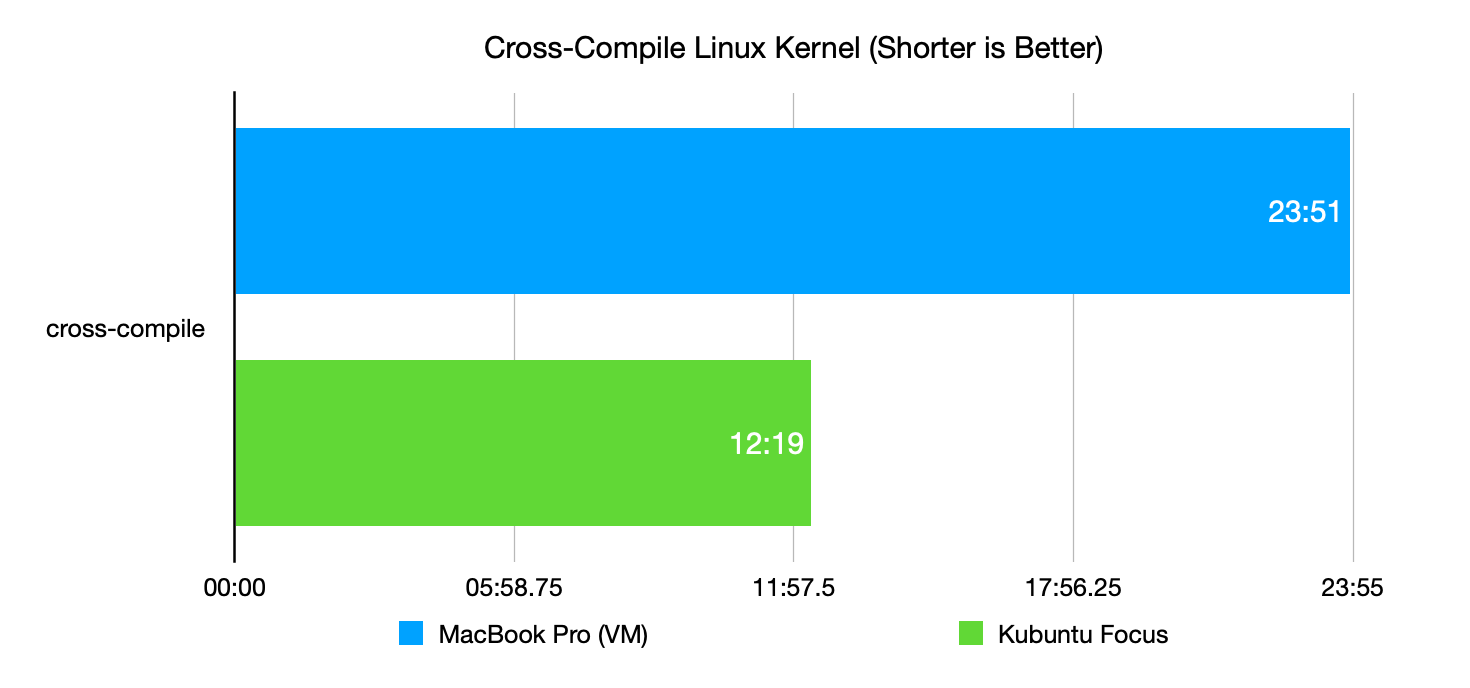
The Focus is again able to beat the Mac, finishing in half the time. Again, I could probably tune my Mac more to get a better result, but it's just easier when you're working with Linux-based tools to run Linux natively.
In general, all my software development workflows are just as good, if not better, on the Kubuntu Focus, and sometimes they're much faster too. So a major victory for the Focus there!
Media Production Workflows
The next thing I wanted to try was my media production workflows. And unfortunately for the Focus, it's more of a mixed bag.
OBS
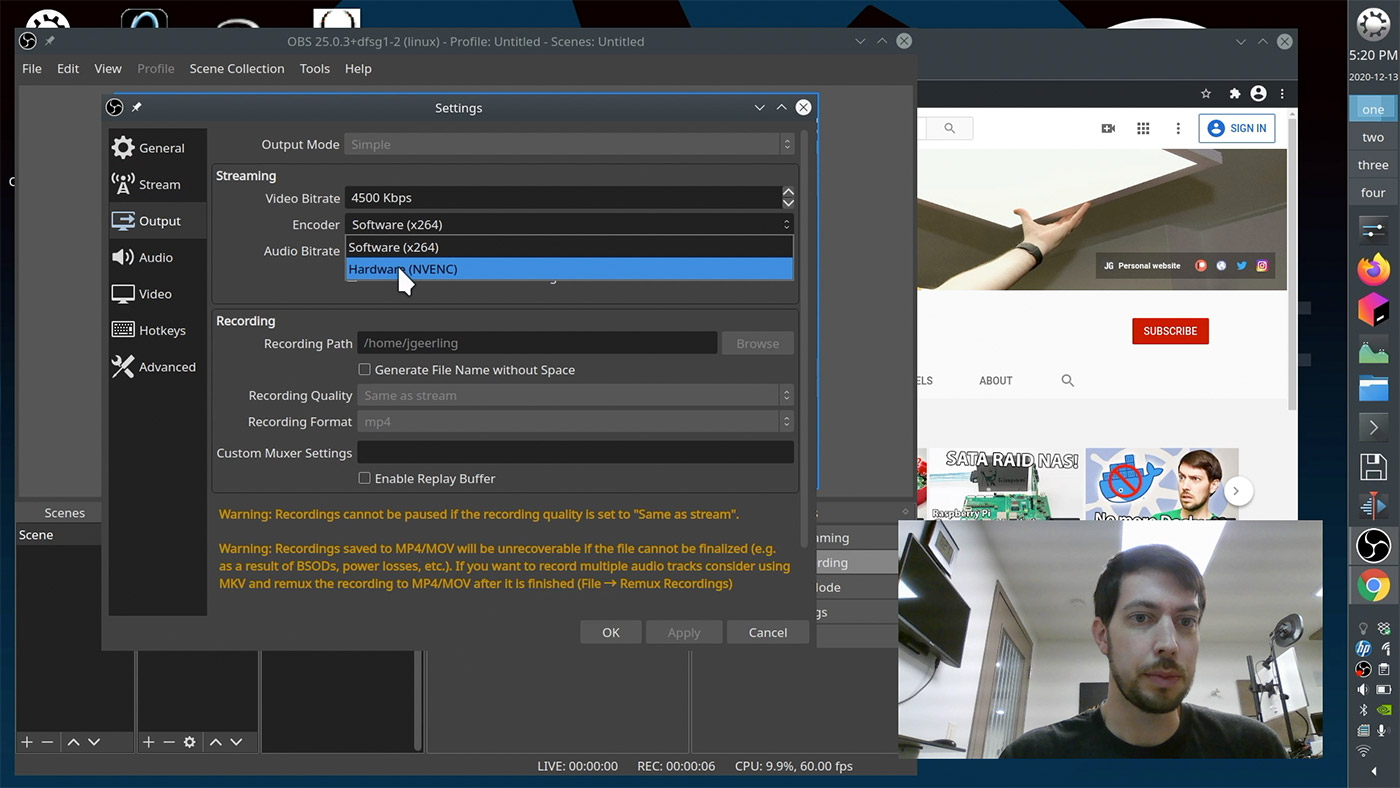
First of all, for screen recording and live-streaming, OBS on this laptop was very stable, and ran a lot more smoothly than on my Mac. There were a few issues when I plugged in all my devices through my ThunderBolt 3 hub, but in general things worked, and the processor didn't seem to get taxed after long periods of recording in OBS, likely due to its Nvidia GPU support.
Issues with External Displays and ThunderBolt
But as I got into editing my footage, I ran into my first major annoyance. On my Mac, I often boot the Mac, then plug in an external display, change resolutions, unplug it, go into clamshell mode, plug it back in, and do almost any order of operations I want. But when I started using the Focus the same way, I ran into quirks.
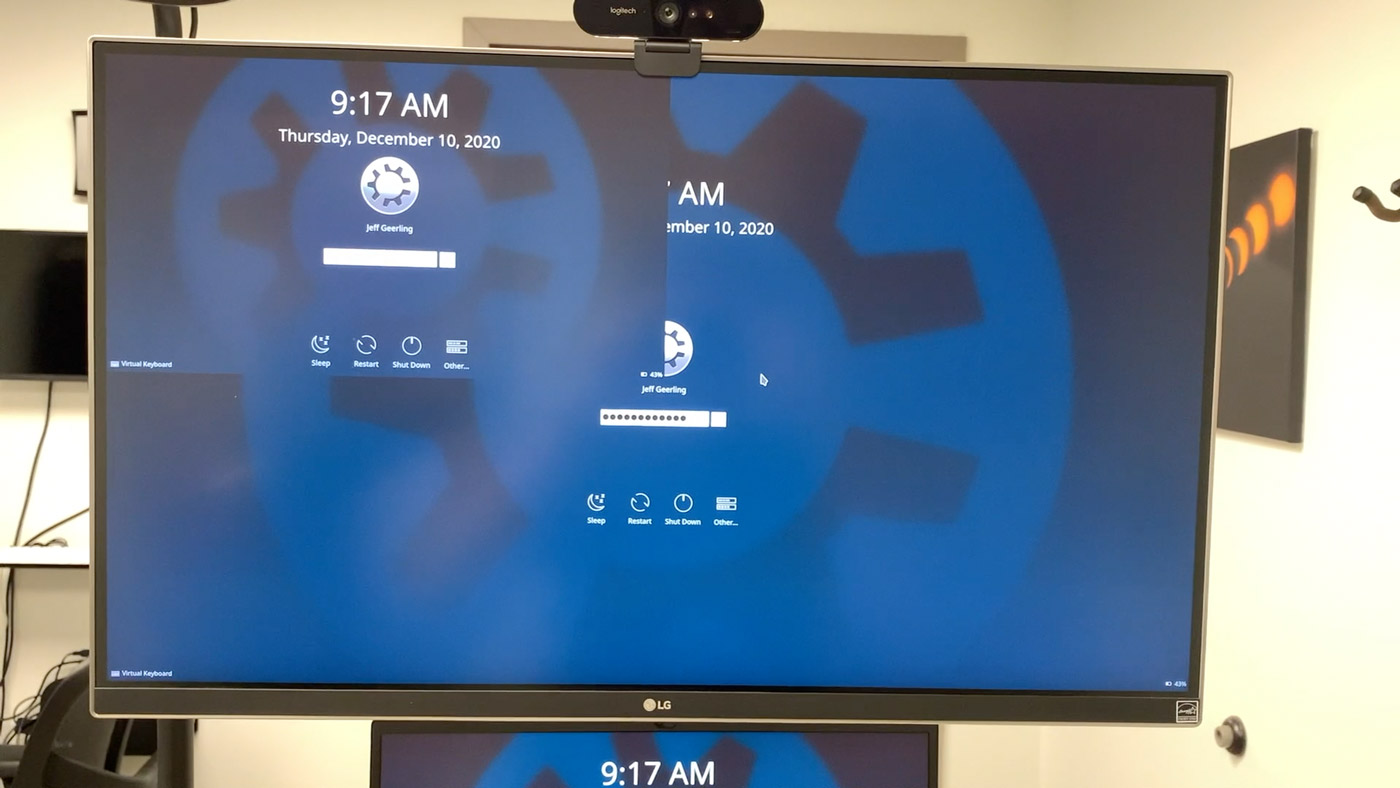
The Mac handles switching between clamshell mode and multi-monitor mode just fine, even when hot-plugging ThunderBolt 3 docks. But on the Focus, I usually had to restart to be able to pick up monitor and resolution changes and get the UI rendering correctly. Sometimes if I tried using only the internal display, my external display would turn on and off continuously. Other times, if I woke the Focus from sleep with my Thunderbolt-connected display, the keyboard would just go AWOL and I'd have to reboot using the trackpad.
Now, I'm sure there are settings I could tweak to mitigate some of these issues, and there are also probably bugs in ThunderBolt 3 drivers, but if the Focus is touted as something that replaces a MacBook Pro and just works, it also needs an asterisk: There are some things Linux doesn't yet do as seamlessly, like resolution scaling, internal and external display detection and switching, and sleep and hibernation in clamshell mode.
To be fair, my Mac does weird things sometimes if I hot-plug it from sleep with multiple displays, but those problems almost always resolve with a quick "close and open the lid" cycle, and it happens infrequently.
With the Focus, a reboot was almost always required, and that's a lot more disruptive.
Video editing with Kdenlive
After deciding to abandon using the Focus with an external display just for the sake of getting work done, I tested it with all my media production hardware:
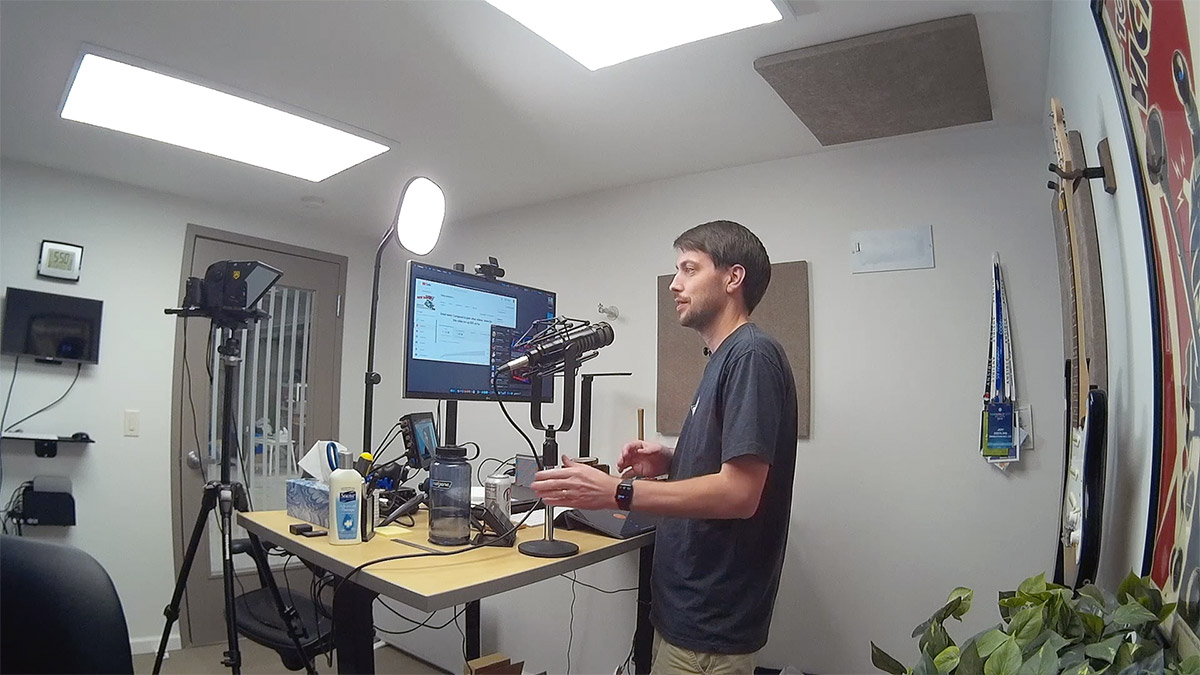
And it really surprised me, how smooth and effortless everything was. I was expecting worse, after trying things out on the Raspberry Pi, but tools like VLC, Audacity, and the Kdenlive video editor are all really good.
No matter what footage I threw at them—AVCHD files from my Sony a6000, ProRes or DNxHD files from my Blackmagic Video Assist 3G, or any type of audio file, it ingested them and played them back without dropped frames.
That is, until I adjusted the volume or screen brightness!
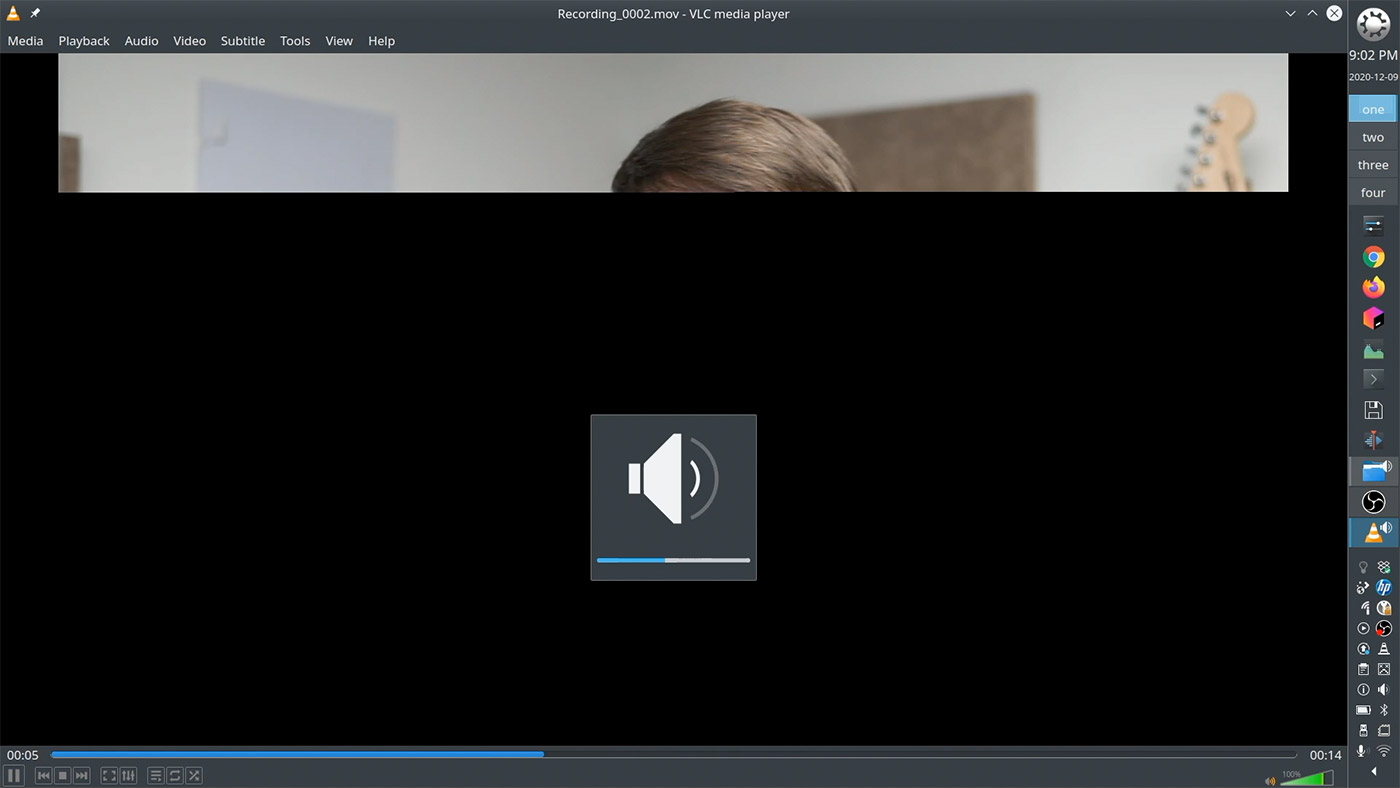
Apparently, rendering the overlays for those things seems to disrupt playback. In VLC it caused tearing and blacked out frames, and it would cause Kdenlive to stutter.
But in general, video editing 'just worked', and while I wouldn't call myself proficient, Kdenlive feels like a solid option—and best of all, it's free!
There are a number of minor annoyances I had moving from Final Cut Pro X to Kdenlive, like the fact that so many options are not exposed directly within the timeline, like adjusting audio levels in an audio clip. But if I used the Focus and Kdenlive for the next month, I'd be at least 80% as productive editing video as I am on my Mac right now.
And that's saying a lot. On the Pi, editing HD footage was so slow I gave up on it. The Focus can handle even 4K footage without a hitch, just like my Mac.
There are some seemingly minor features missing, though, that make up that last 20% of productivity. One glaring example is Kdenlive's importer.
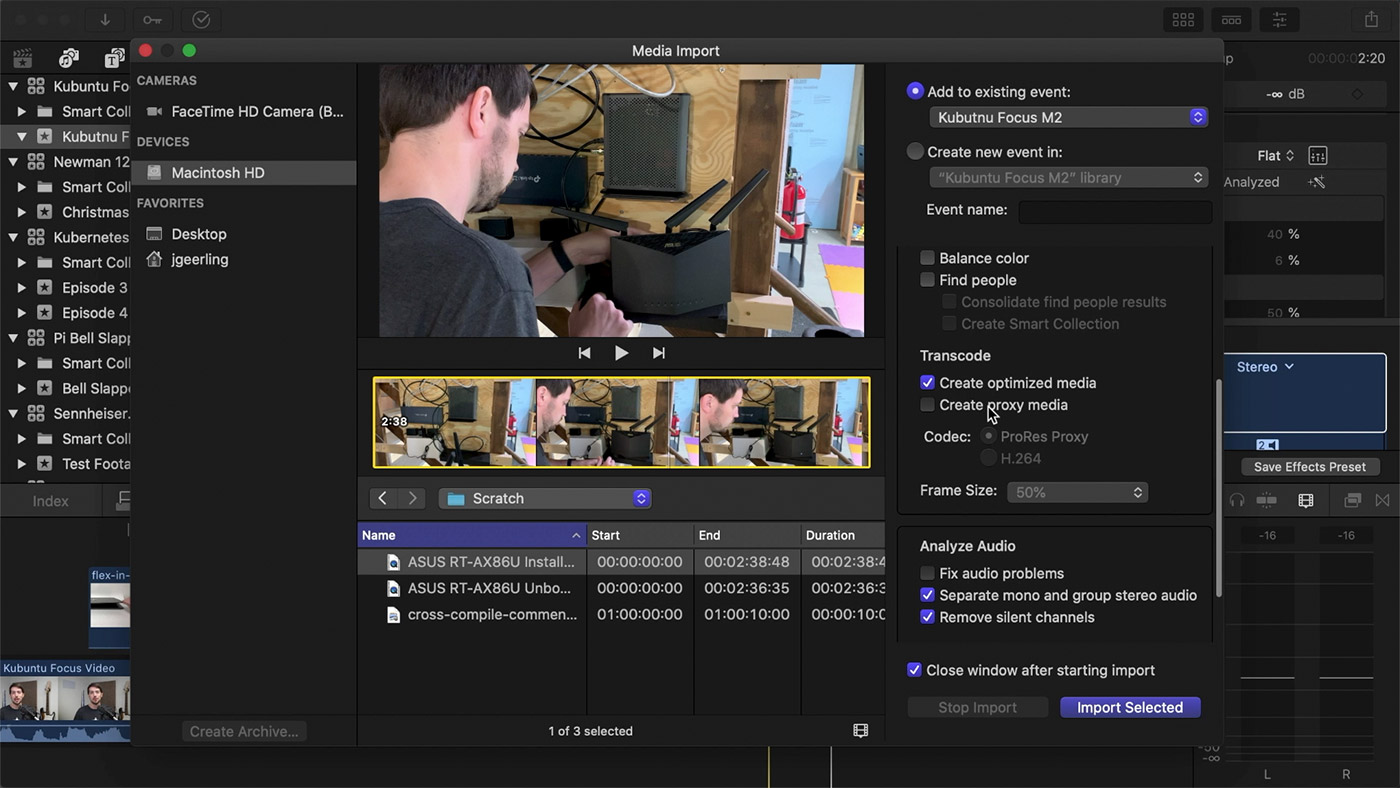
On my Mac in Final Cut Pro X (pictured above), there are tons of options to help the ingest and organize media; you can create proxy media, import and copy at the same time, consolidate a project's media files, and work from multiple drives or over the network more easily.
In Kdenlive, you have to do a lot of the plumbing yourself before you can get media inside the editor.
Between that and many of the little differences like audio adjustments, video generators, and title editor differences, I wouldn't willingly give up what I pay for in Final Cut Pro X, because either the quality or quantity of video I produce would suffer a little.
Photo Editing
One other thing I do a lot, though not quite as much this year, is post-process batches of RAW files from my cameras, like my Nikon D700 and D750.
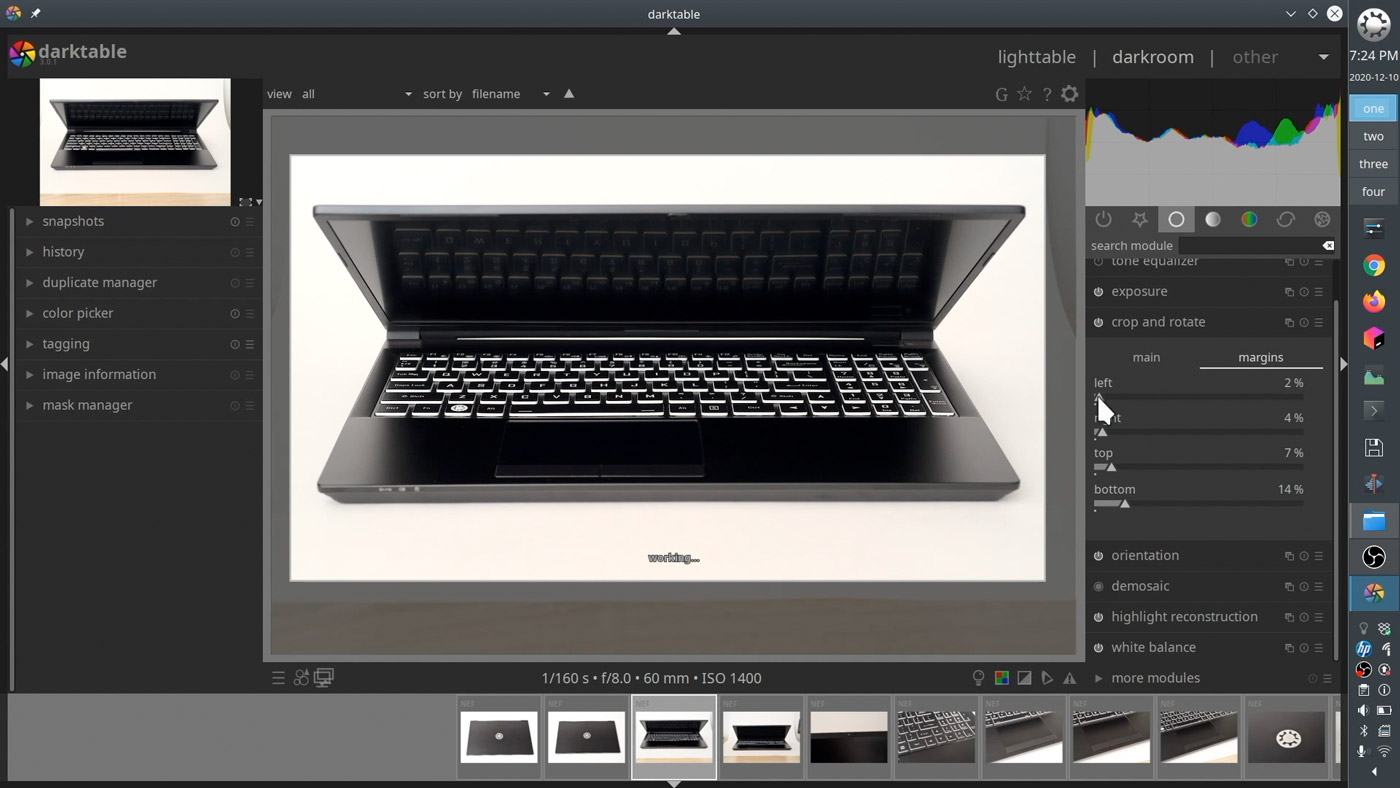
I tried out the included Darktable app, and it was generally good. It reminds me a lot of the Lightroom interface, though there are a few options and UI elements that I missed when tweaking image exposure and color options, or quickly retouching an image outside Photoshop.
On my Mac, I use Fast Raw Viewer, Lightroom, and Apple's built-in Photos app to process for this workflow. Darktable seems an adequate and snappy replacement for the ingest and editing, but the main thing I would miss from Apple is the iCloud Photo Library integration.
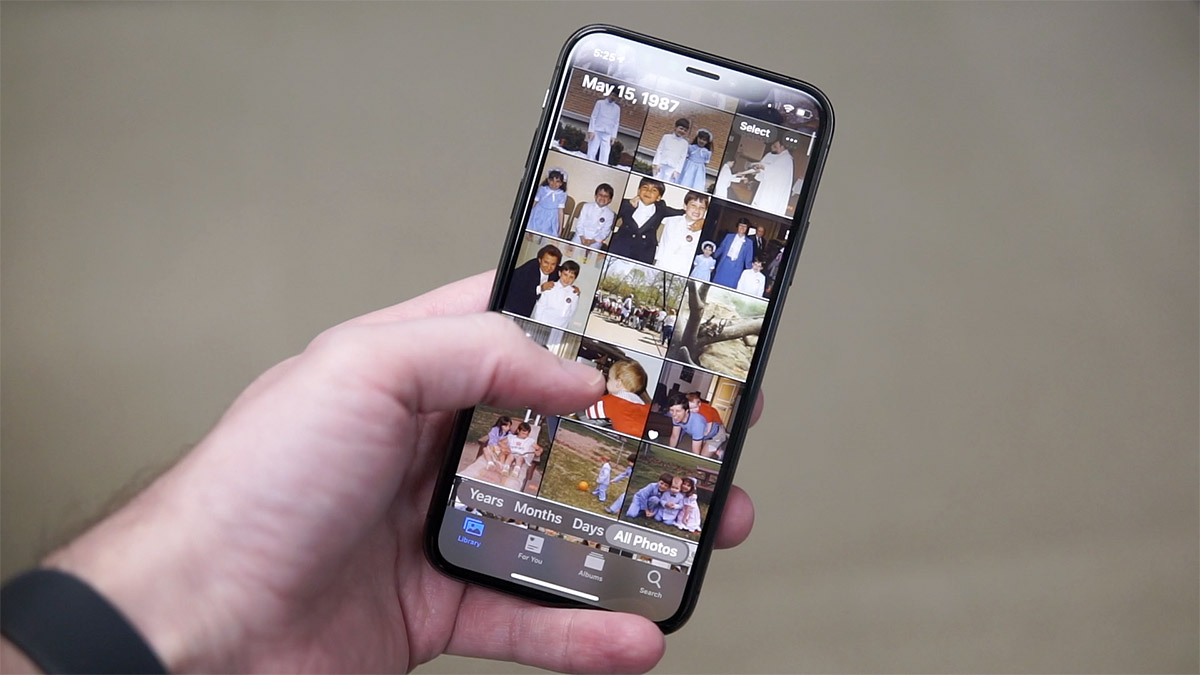
Having every photograph I've ever taken in my hand and backed up in three places (I have a separate Mac that is dedicated to daily snapshot backups of my entire photo library, synced through iCloud and then backed up using rsync) within seconds of importing them is very nice, and trying to replicate that same workflow with open source software requires a lot more setup.
But it's something I'd be willing to do, since photo-editor-wise, GIMP and Darktable would take care of my needs.
If Apple still made Aperture, it'd be a different story. I absolutely loved Aperture for photo processing, and wish it were still a thing. But oh well.
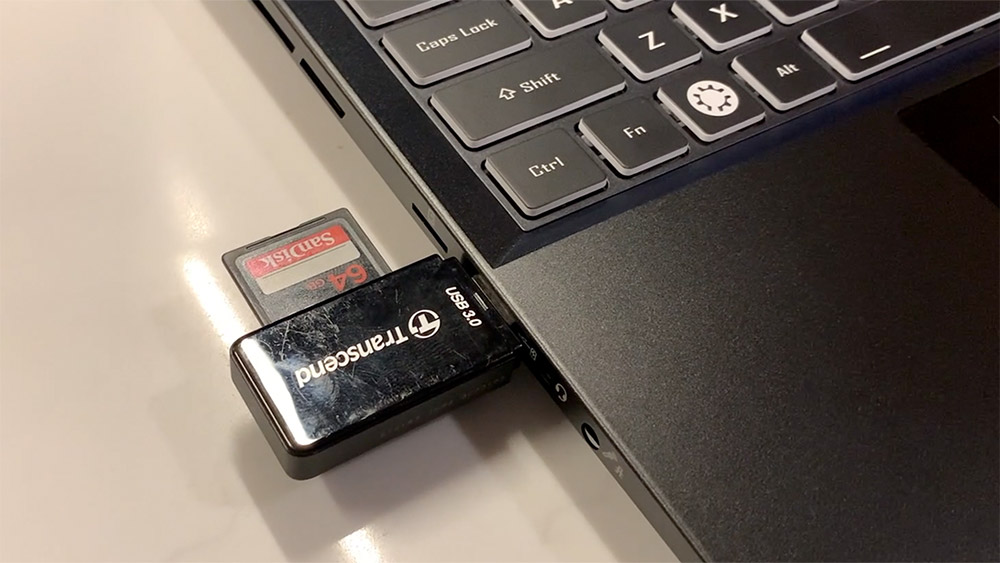
One minor gripe I had with the Focus was it only has a microSD card slot, not a full-size SD slot, but I'm used to the dongle life with my current Mac, so I got over it.
Gaming on Linux
One thing I don't do at all on my Mac is play games. I was interested in trying out Steam Play on the beefy Focus laptop, since it has better gaming specs than any computer I own.
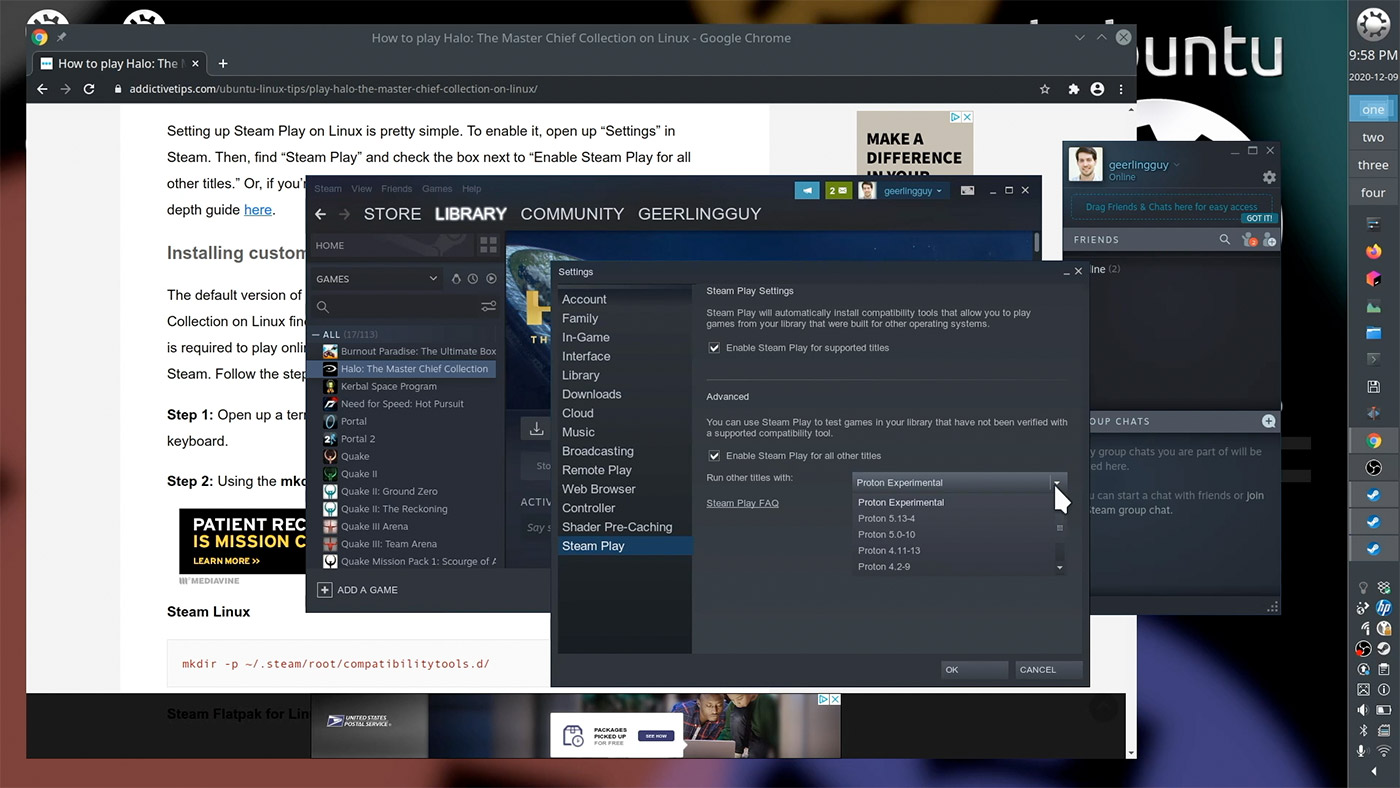
'Steam Play' lets Windows-only games run on Linux using Proton. I tested a few of the games in my library, and they mostly ran without a hitch, though the fans would go into rocketship mode during gameplay, getting slightly louder than my MacBook Pro at full-tilt.
I played Quake to make sure things worked smoothly, and they did. Then I tested out Portal, and it ran perfectly smooth. Finally, I spent a little time trying to get my favorite game of all time, Halo 3, running, but I kept having problems launching the Master Chief Collection:
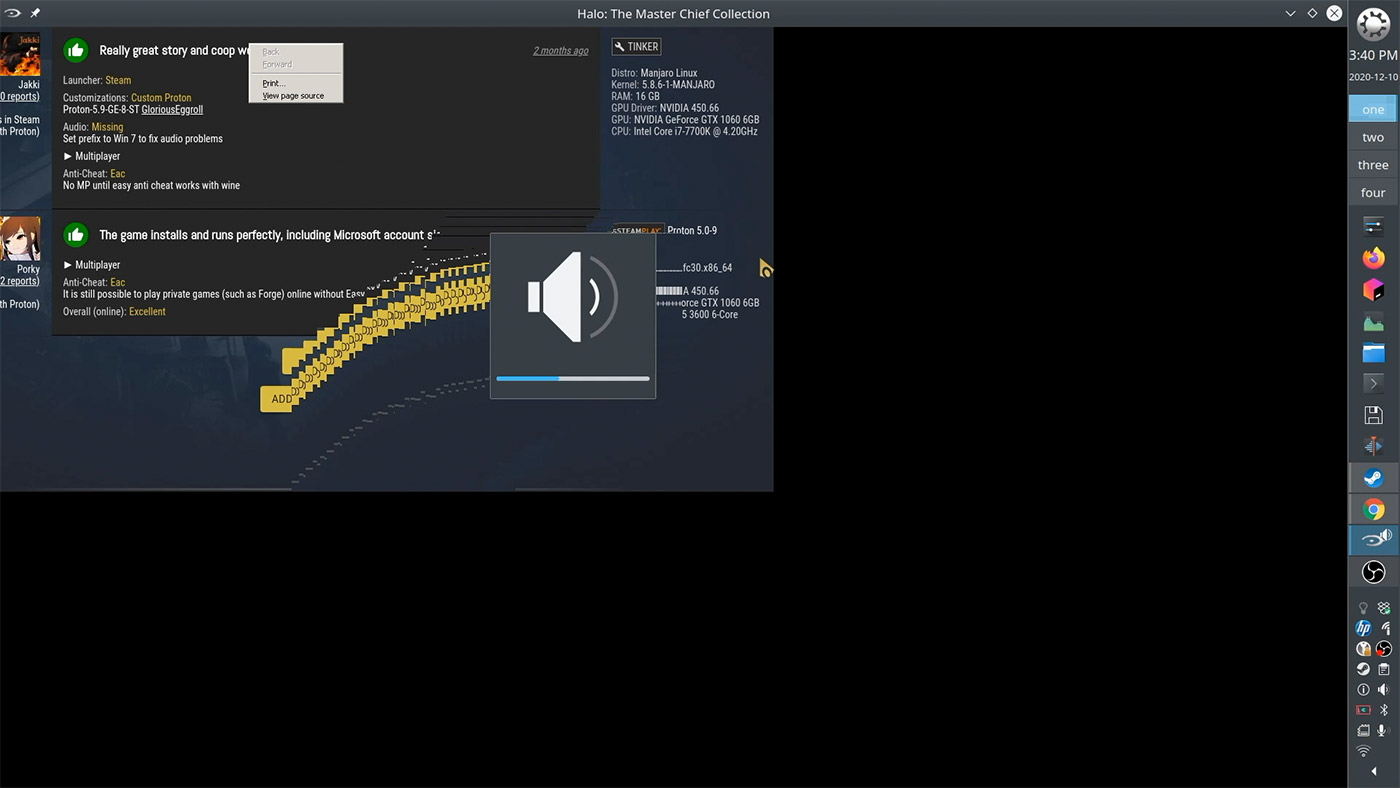
I tried it in windowed mode, and I could hear the load screen music after a while, but the screen would never render.
Other people seemed to be able to run it, so I could probably make it work if I invested more time... but for now I'm happy to play it on the Windows PC I keep around for testing.
Conclusion
There are a lot of other things I could talk about, but I'll sum up a few of the major points here:
Battery life was a little disappointing, especially with the GPU enabled. And having to log out and log back in to switch graphics options for better battery life was annoying. I only went through a few full battery cycles, but it seemed to last an average of about 2-3 hours (for my development and editing workflows—not light web browsing use!).
My MacBook Pro regularly gets three to five hours of battery with automatic graphics switching for the same kind of usage, so it would take some adjustment to have to go back to bringing a power brick with me most places.
The built-in speakers were also a letdown compared to the MacBook Pro. The sound from my 15" Mac has a richness you wouldn't expect coming from a laptop. I edit a lot of videos just using the onboard speakers on my Mac—they're that good!
But I wouldn't do the same on the Focus. It's speakers are about average for laptop speakers: adequate, but not impressive.
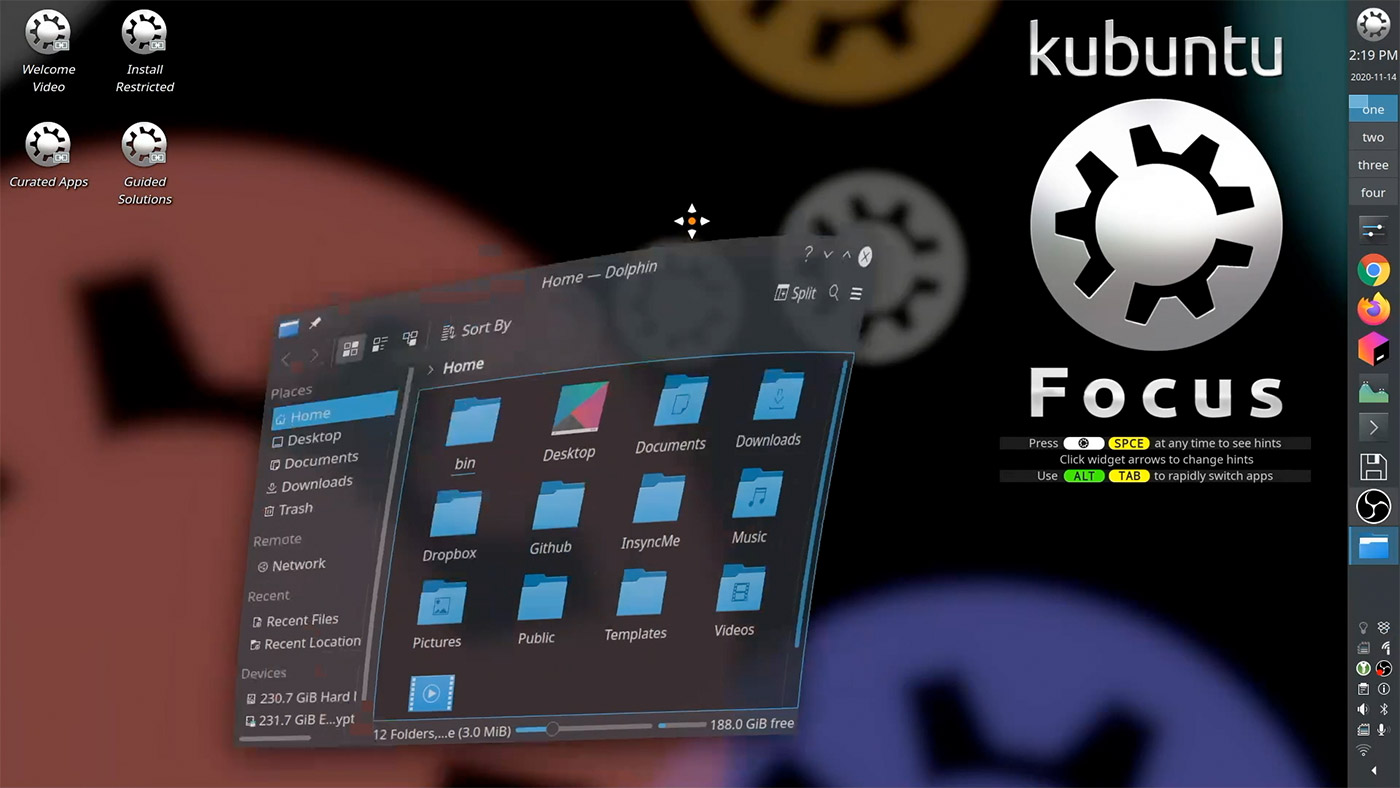
The final thing I'll note is there are some default UI features, like wobbly windows, that just feel tacky, and remind me of when Apple used to turn every UI element into a giant piece of candy or Windows added rampant glassy effects all over the UI just because they could. It doesn't make for a better user experience, and I wish those kind of features were disabled out of the box.
There are few very tiny UI annoyances like that I ran into here and there (like tab behavior differing from app to app—most notably the impossibility of moving tabs between Dolphin file browser windows), but that's getting into the realm of the subjective, so I'll leave it there.
To conclude, I think this laptop performs very well, right in the same class as a high-end Mac, Dell, or Lenovo laptop. For my own needs, if I didn't need a couple features, like my media editing workflow, and a better clamshell experience, I would consider this laptop.
But because of my workflow and software needs, I still prefer my Mac.

But would I recommend the Kubuntu Focus M2 to someone considering the jump? Yes. It's a fast, well-rounded laptop, and you could do a lot worse than Kubuntu Linux for a desktop OS. For certain users, especially developers not tied to strongly into a Mac or Windows-only workflow, it's a great option, ready to go out of the box.
For more information or to order one, check out the Kubuntu Focus website.
Comments
Man, I read this whole post off of a link on lobste.rs before realising it was written by the same person whose Ansible roles I use and learned from. Thanks, Jeff!
Awwww what a sad story. Fat plastic laptop with tiny touchpad without haptic Touch or even multitouch... for sure tft screen and high and old keyboard... thats why its chepest laptop than macbook. For example macbook is tiner than pencil so you can imagine that :)
Thanks, Jeff.
The problem I had with your previous review was that you were comparing a $3K laptop with a $75 embedded desktop, which never seemed fair.
I get that you don't want to carry around 2 laptops but for scenarios that don't require high throughput, I could see you doing more desktop work over X11 by ssh-ing into your Pi CM4 dramble cluster!